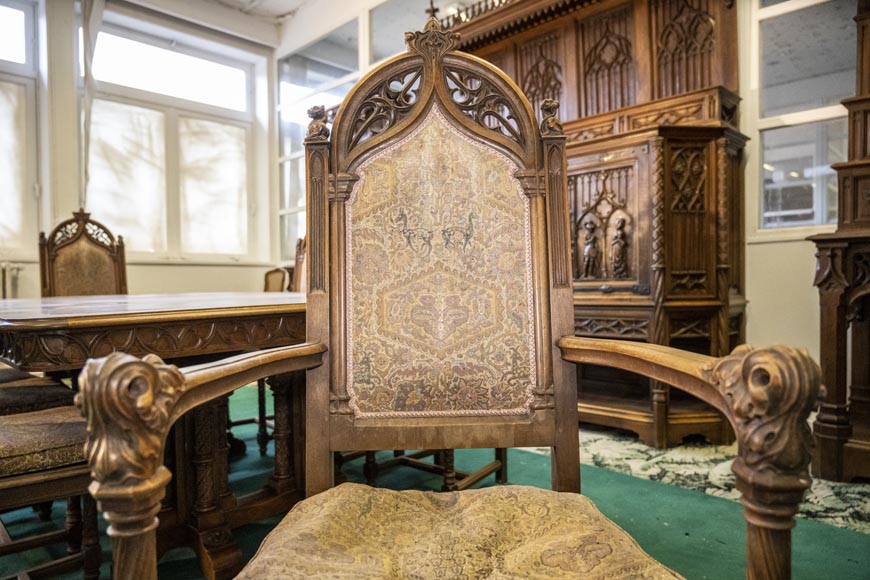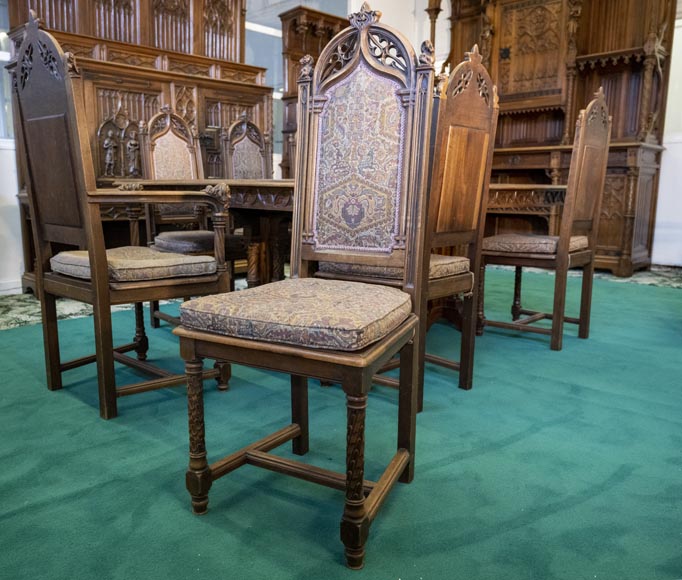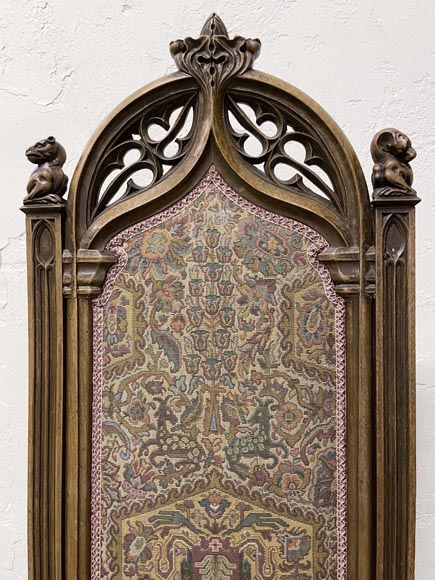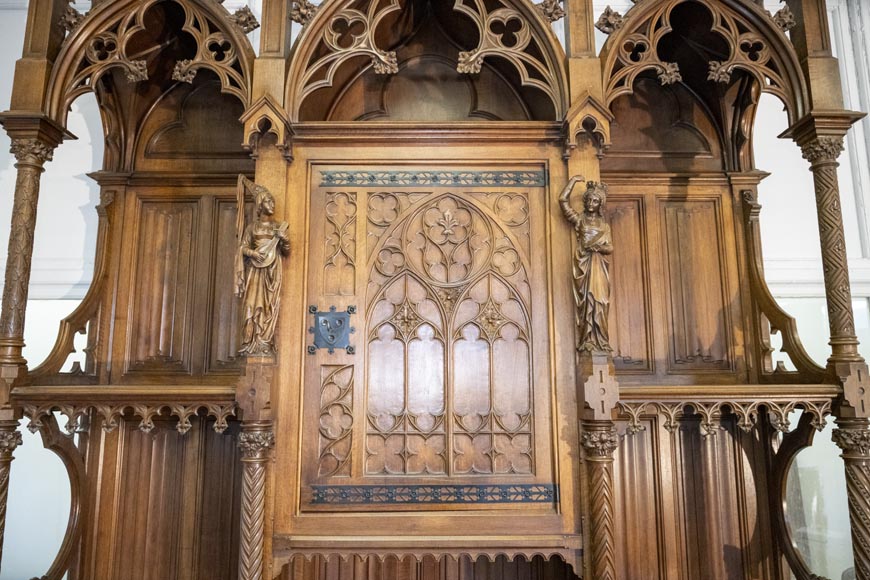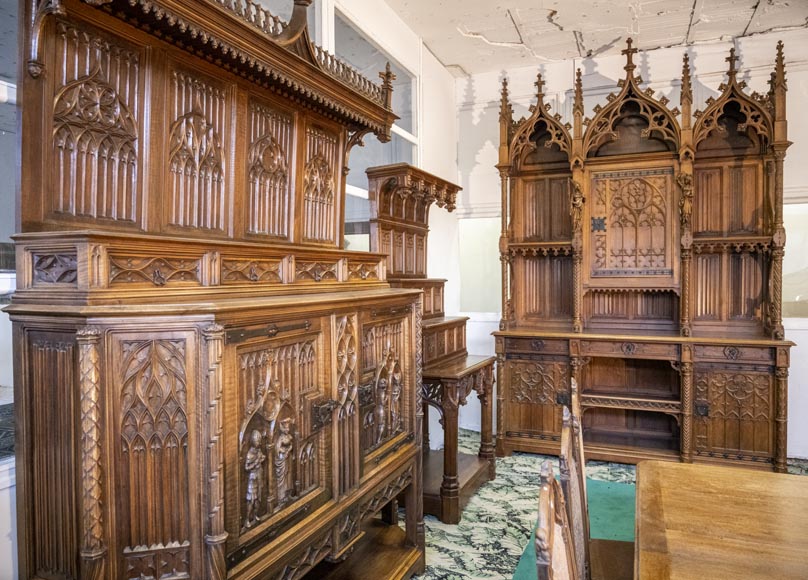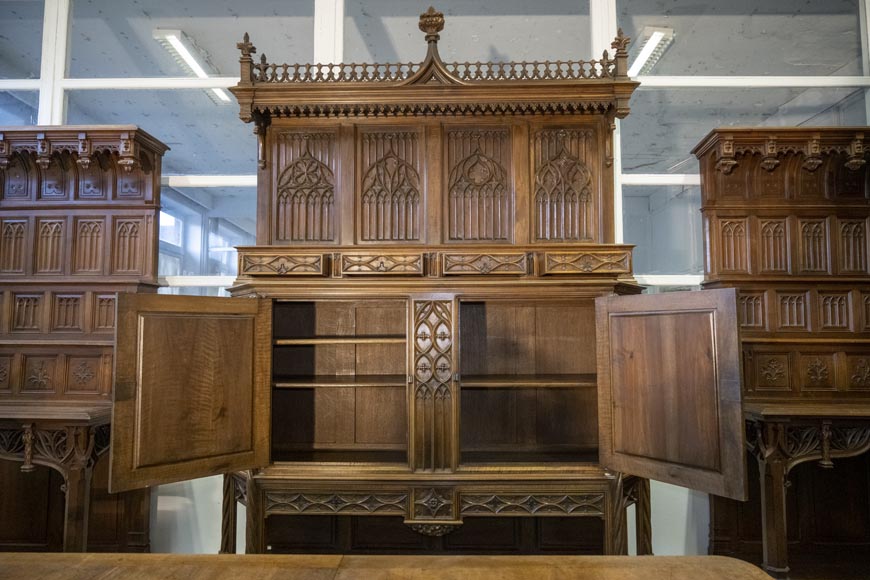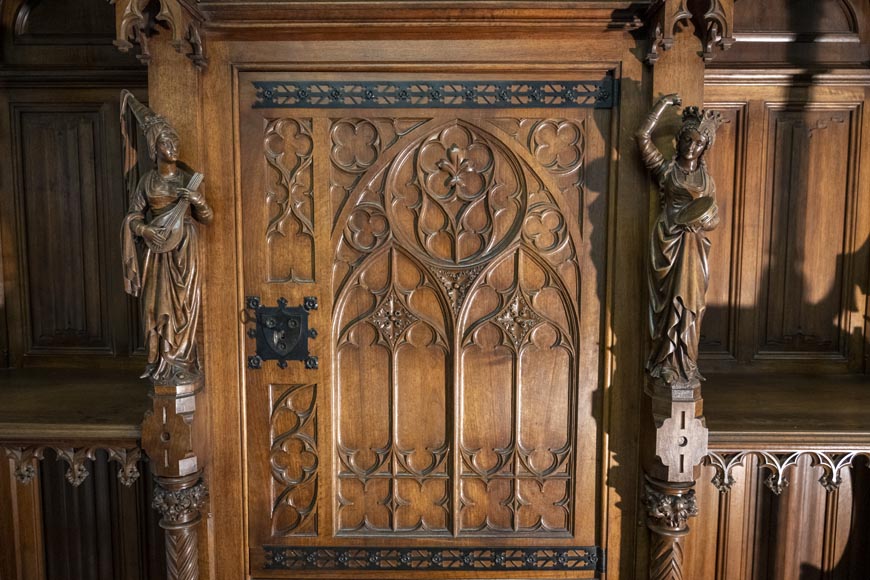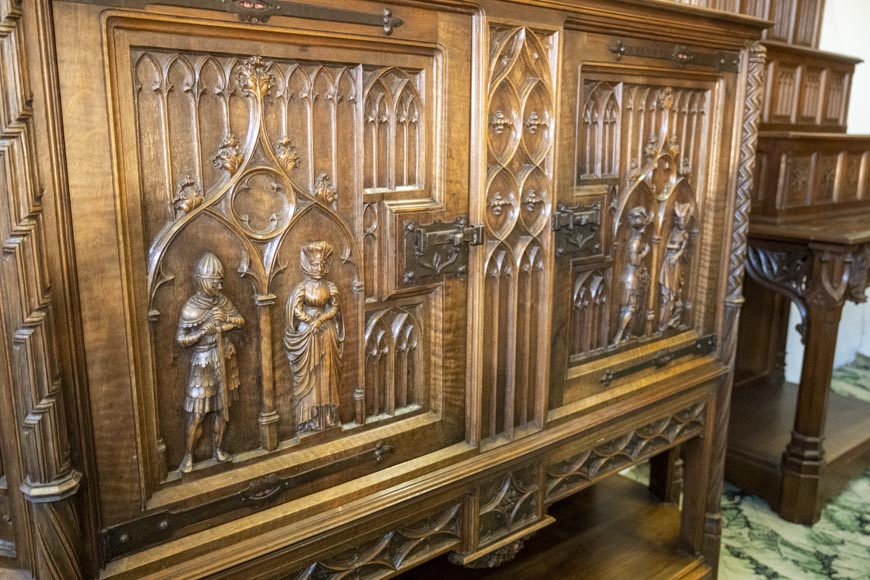Style Neo-gothic / Ref.12332
In the style of VIOLLET-LE-DUC, Exceptional Neo-Gothic Dining Room, 19th Century
Dimensions
Width 87'' ¾ 223cm
Height 137'' ¾ 350cm
Depth: 27'' ⅛ 69cm
Origin:
19th century
Status:
Good condition
This neo-Gothic dining room suite, comprising a grand sideboard, a buffet, two dressers, a table, and eight chairs, was crafted in the 19th century in the spirit of the celebrated medieval revivalist Eugène Viollet-le-Duc.
The grand sideboard displays intricate and richly detailed carvings, inspired by the architecture of the 15th-century flamboyant Gothic style. Its numerous open shelves make it a piece of prestige rather than utility. The lower section features two lateral cabinets adorned with low-reliefs resembling a stained-glass window with lancet arches, trefoils, and quadrilobes. The central open shelf is bordered by a railing adorned with opposing trefoils. Each section is flanked by columns with alternating twisted, stepped, chevron, and foliated patterns, reminiscent of the polychrome decorations in neo-Gothic churches. Alongside the carved details, metallic friezes and shield-shaped locks enhance the piece. The central belt contains three drawers with trefoil handles. The upper section of the sideboard has multiple levels: to the right and left, an initial tier of open shelves framed by twisted and beaded columns, or chevrons. The back of these shelves is decorated with napkin-fold motifs, and the top is adorned with a series of trilobes. The second tier is similarly adorned, with slight variations for visual interest. At the center, a cabinet door mirrors the design of the base. A small fleur-de-lis, a symbol of French royalty, adds a historicist touch to the piece. On either side stand two female statuettes under canopies: one, wearing a hennin and pointed shoes in the 15th-century style, plays the lute, while the other holds a tambourine. The sideboard is crowned with three ogee arches adorned with cabbage leaf carvings, separated by pinnacles.
The second buffet, with its stepped and paneled design, appears more utilitarian. The lower, open section is topped with a canopy decorated with architectural motifs. The central part resembles a large chest richly carved and equipped with two panels locked with bolts. Each panel depicts a couple – a knight and a lady – evoking courtly love. The ladies wear escoffions, while the knights are dressed in different armors. These figures are set within an architectural frame forming an ogee arch topped with cabbage leaf carvings, extending into lancets and gothic window motifs. The structure is again punctuated with columns. The sides of the chest are beveled, featuring additional large window motifs; this continues along the buffet’s short side, adorned with a napkin-fold motif. Above the chest is a set of recessed drawers, topped with a canopy with a background of varied stained-glass window motifs, complemented by a balustrade and five pinnacles.
The dresser, a furniture piece dating back to the Middle Ages, was intended for displaying dinnerware in reception halls. Our dressers are particularly interesting as they draw direct inspiration from a model designed by Viollet-le-Duc in his Dictionnaire Raisonné du Mobilier Français de l’Époque Carlovingienne à la Renaissance, where the author emphasizes the ceremonial nature of the dresser, which had as many levels as the owner’s nobility permitted. The front of the dresser forms a credenza resting on four legs designed as architectural pillars. The front is joined by an ogee arch decorated with trilobed cutouts, flanked by sculpted colonnettes. Each subsequent level is adorned with rectangular cartouches featuring floral motifs, lancets, and stained-glass windows. The topmost level forms a cornice ending with trilobed openings and leaf pendants.
The table also embraces the neo-Gothic style. Its legs feature numerous ringed columns, each with unique sculpted motifs and topped with cabbage-leaf capitals. The tabletop is bordered by a band carved with opposing trefoils, reminiscent of those on the buffet’s balustrade.
The eight chairs, finally, incorporate Gothic architectural motifs and sculptures. The front legs have light low-relief carving, while the backrest is adorned with a tall lancet topped by a sculpted fantastical creature, recalling medieval gargoyles. The top of the backrest is crowned with an ogee arch topped by cabbage leaf carvings, connected to a rounded arch; between the arches, the spandrels are decorated with stylized trefoils. The seat is cushioned with fabric echoing the ornamental richness and animal and floral motifs typical of medieval millefleur tapestries. The fantastical animals twisting on the chair backs are also inspired by Viollet-le-Duc’s art, one creature resembling an elephant he designed for the Château de Pierrefonds, preserved in his archives.
This magnificent dining room is thus inspired by the work of architect Viollet-le-Duc, a major figure in neo-Gothic art in the 19th century. It is exceptionally rich and cohesive, forming one of the most refined furniture suites in this style.
Informations
Price: on request
Recommended for you :
Dimensions:
Width: 303
Height: 76
Depth: 115
Dimensions:
Width: 191
Height: 293
Depth: 56
Dimensions:
Width: 72
Height: 76
Depth: 105
Dimensions:
Width: 122
Height: 76
Depth: 82
Dimensions:
Width: 230
Height: 274
Depth: 69
Dimensions:
Width: 172
Height: 79
Depth: 106
Dimensions:
Width: 85
Height: 82
Depth: 57
Dimensions:
Width: 60
Height: 283
Depth: 33







